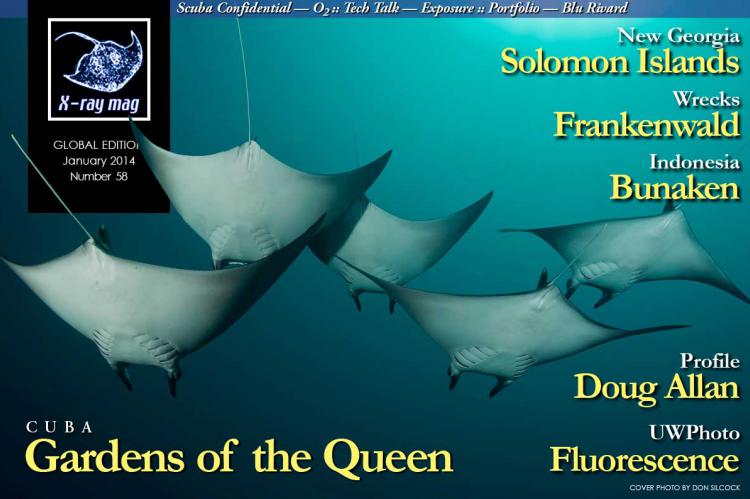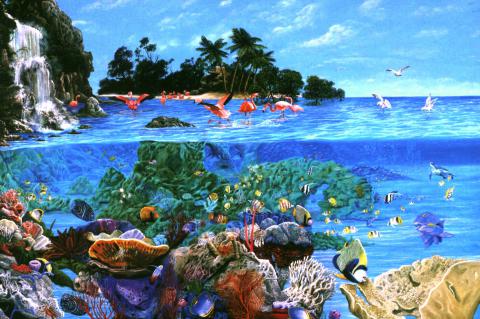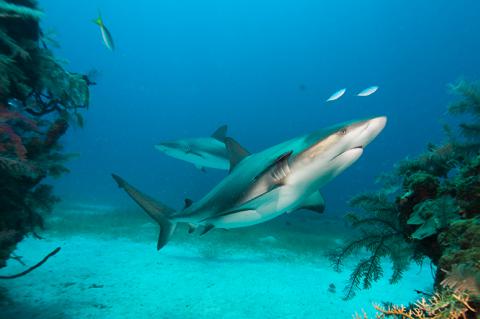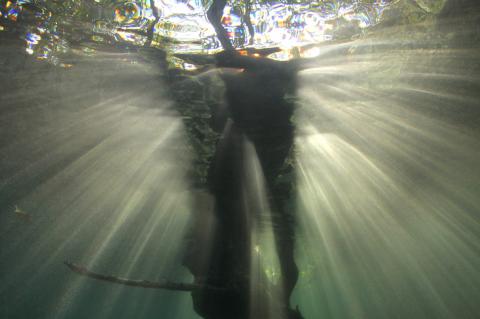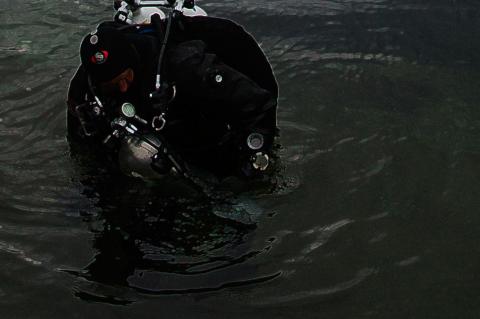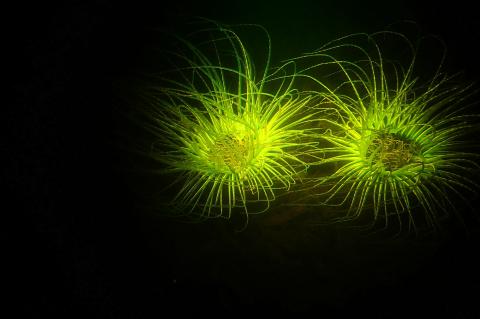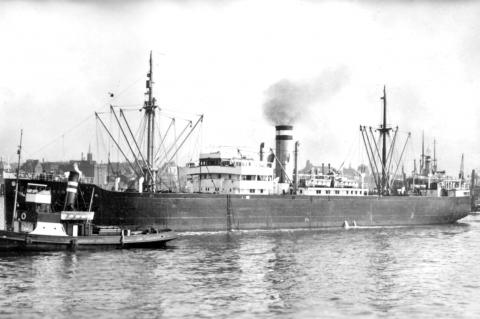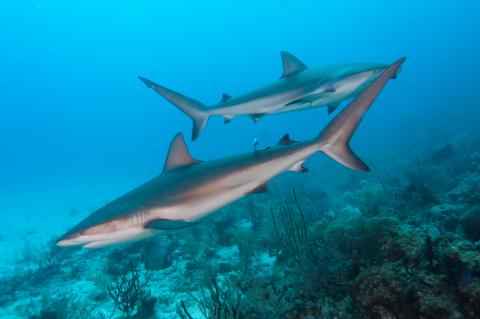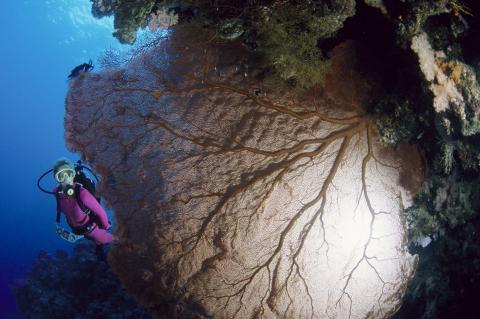X-Ray Mag #58
Cuba's Gardens of the Queen; Indonesia's Bunaken; Solomon Islands' New Georgia; Norway's Frankenwald wreck; Fluorescent Night Diving; Doug Allan profile; Dive Fitness on Back & Biceps; Scuba Confidential on O2; Sharks Close to Extinction; Tech Talk on Exposure; Blu Rivard portfolio; Plus news and discoveries, equipment and training news, books and media, underwater photo and video equipment, turtle news, shark tales, whale tales and much more...
Main features in this issue include:
Blu Rivard Portfolio
Based in Southern California, American artist Blu Rivard is passionate about the underwater world—a realm of wonder which he captures in vivid oil paintings on canvas. An avid scuba diver, he found inspiration for his art in his diving adventures in places such as Australia, Asia and islands of the South Pacific. His passion for the beauty of life in the sea led to a desire to help protect the oceans and the fragile ecosystems of the reefs
“The sea and its residents fascinate me in many ways,” said Rivard. “Each has a role to play in the scheme of things.”
Leaving his native Detroit in the late 70’s, Rivard came to live in Southern California and developed a love of the sea and its many creatures.
Cuba Gardens of the Queen
As the wheels touched down at Havana’s International airport, the plane erupted with cheers and applause. Many of the passengers on board had waited years, if not decades, to return home and visit relatives in Cuba. As part of a small group of Americans visiting for the first time, I knew immediately that we were in for a special treat.
Cuba — Photojournal
The Cuban government is environmentally minded. In 1996, the 837-square-mile marine area and archipelago of Gardens of the Queen located south of the main island of Cuba became a no-take reserve—the largest in the Caribbean—and in 2010 was designated a national park.
The reefs of the park host an exceptionally healthy marine ecosystem. When visiting the dive sites you will witness lush coral forest with abundant fish populations. Many of the dive sites are walls that bottom-out at around 60 to 100-feet (18 to 30m).
Diving Indonesia’s Bunaken
We’re swimming fast. Too fast for my liking. I’m taking heaving gulps, and I know my tank won’t last very long if we don’t slow down soon. Just as I’m about to stop and risk losing my group, we hear a rapid series of bangs coming from our dive boat in the distance. Our guide, a lithe Indonesian with pistons for legs and bottomless iron lungs, points into the blue and somehow quickens his pace.
A few meters ahead to my left, my cousin, Kate Clark, an accomplished diver and tireless swimmer, senses my fatigue and looks back to make sure I haven’t quit on her. She slows her speed a bit, trying to be a good buddy and stick with me.
Exposure—How Long, How Deep, How Cozy?
Staying Alive: Application of Risk Management in Scuba Diving.
I’ve had the privilege to dive on the wreck several times; the first was in the aftermath of Hurricane Hortense, which blew its way up the eastern seaboard of North America, and although it did not hit Rimouski directly, turned that late Quebec summer into a mini-maelstrom. The weather was awful—windy, wet and bleak. It had kept us out of the water and holed up in a small hotel for days, playing euchre and praying for a break in the weather.
Flourescent night diving on the rise
Fluorescence night dives, or fluoro, UV and glow dives, as they are also known, are becoming increasingly popular as more and more dive centres offer scuba divers and underwater photographers the chance to experience this unique underwater phenomenon.
The basics—what is it?
Fluorescence is the capability of certain materials to absorb light transmitted on one wavelength and then emit it again nanoseconds later on a different wavelength. The phenomenon occurs in certain living organisms, various minerals and in petrified fossils.
Frankenwald - A World-Class Wreck Dive
On 6 January 1940, the German freighter Frankenwald was caught in a treacherous current on the Norwegian west coast. With a deafening noise, German steel met Norwegian rock, and ship and cargo was lost. All that's left now is a world-class wreck dive.
Perhaps the captain takes a moment to think about his homeland, which just a few months earlier was plunged into war. He is safe here inside the Norwegian fjords; but, in international waters just off the coast, the Royal Navy is looming.
Hunted Out of Fear
The shark is an apex predator that has been on this earth for over 400 million years—a predator that, through the media and our deep-seated fears, has been systematically targeted and hunted throughout the world's oceans, pushing many species close to extinction.
It is the phrase that Scuba Junkie Mabul Resort on the east coast of Borneo has been using over the last seven years when talking passionately about the area in which they take people diving on a daily basis, and about the sharks that they have been trying to protect in the area over that time.
Solomons - The Spirit of Morovo
A dark cloud developed ahead of me. Curious, I swam nearer to investigate. The cloud billowed getting bigger and darker. Inside flashes of silver struck like a highveld thunderstorm. The cloud undulated with tumultuous movement.
Where is the O2?
In many cases, there is actually no plan to deal with a DCI incident. The rationale given runs along the lines of, “It hardly ever happens, so it is not worth thinking about until it does.”
I was a guest on a dive boat a few months ago. We had just arrived in Crystal Bay, a notorious diving accident black spot on the outlying Balinese island of Nusa Penida, when our attention was drawn by a burst of frenetic activity next to a neighbouring boat. A wetsuited figure was being manhandled over the side of the boat and laid out on deck. A couple of crewmen hunched over the figure while everyone else on board stood to one side, heads craned in concern. Seeing us approach, one of the crew shouted over and asked if we had oxygen.


